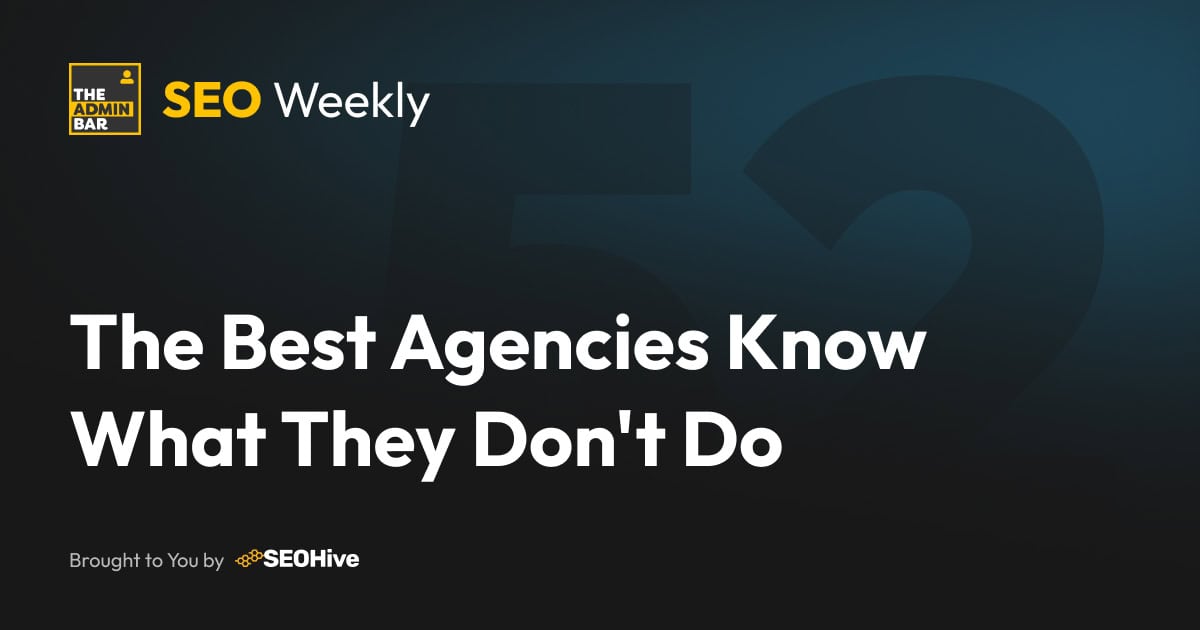This week, it’s time to substantiate something I’ve been mentioning in a few SEO Weeklies over the past few months…
Like I keep saying, as web professionals, we have a duty to our clients. When someone hires us to build their website, they’re not just paying for pretty pixels and smooth animations or for us to use our favourite tech stack.
What they’re actually doing is investing in a business tool that needs to work. And in today’s digital landscape, a website that isn’t able to show up in search (be it organically, or in one of the various SERP features), it simply isn’t fit for purpose.
That’s not to say you should be delivering 100’s of blog posts or a fully comprehensive content plan – your job in building a site is to deliver a framework that CAN deliver.
A previous podcast guest of mine once described it as “websites are born” – and this explains it very well. You need to build all the infrastructure a client may need. It’s up to them to nurture it and grow it through ongoing work. But if you don’t get that infrastructure right from the off, then you’re not really delivering for them on that investment.
So, let’s put that right…
The Actual Problem
Here’s what I see happening far too often: agencies and freelancers deliver beautiful websites that are simply not viable for search engines. The client gets excited about the design, launches with fanfare, and then… crickets. No organic traffic. No leads. No ROI. This is more than disappointing – as far as I’m concerned, it is professional negligence.
Your success is actually a reflection of their success…
So what should we be building into every single website project? Let’s break it down, here.
Technical Foundation
Site Architecture and Structure
✅ URL Structure: Implement clean, descriptive URLs that follow a logical hierarchy.
✅ Site Navigation: Create intuitive navigation with proper internal linking structure.
✅ XML Sitemaps: Generate and maintain comprehensive sitemaps for search engines.
✅ Robots.txt: Configure proper crawling directives for search engine bots.
Performance Optimization
Fast loading times are crucial for both user experience and search rankings. Focus on Core Web Vitals optimization, implement proper caching strategies (browser and server-side), and use lazy loading for images and videos.
Compress images and adopt modern formats like WebP to reduce file sizes without sacrificing quality. Tools like Perfmatters and EWWW.io are perfect for this.
Also, you must take time to understand how your tech stack handles image delivery natively — this will help you identify what’s already working efficiently and where improvements are needed. There’s no sense in reinventing the wheel if it’s already rolling smoothly.
Content Strategy and On-Page SEO
Keyword Research and Planning
Every web project should start with thorough keyword research to identify target terms for each page. Ideally, this will also include some content gap analysis based on competitor research and map keywords to specific search intentions to ensure your content meets user needs. This research then needs compiling into a topical map. (If all this sounds like gibberish, we have a Keyword Research process at SEOHive that will deliver just this! Feel free to DM me).
On-Page Elements
- Title Tags: Craft unique, descriptive titles for each page (50-60 characters).
- Meta Descriptions: Write compelling descriptions that encourage clicks (150-160 characters).
- Header Structure: Implement proper H1-H6 hierarchy for content organization.
- Schema Markup: Add structured data to enhance search result appearances.
We’ve covered ALL of those in previous SEO Weeklies!
Mobile and Accessibility
Your website must work flawlessly on mobile devices since Google uses mobile-first indexing. Implement responsive design with touch-friendly interfaces and ensure your site meets WCAG accessibility guidelines. This includes providing alt text for images and ensuring keyboard navigation functionality. Using tools like Browserstack can help you ensure that websites are delivered and work as expected AFTER they’re fully populated.
Content Management
CMS Considerations
Making sure you provide the client with the access to control their own SEO output in the back end of your CMS (i.e. WordPress) is also vital for the delivery of your project. Using tools like SEOPress Pro or SlimSEO Pro are key to making this happen.
Security and Trust Signals
Ensure that HTTPS is implemented properly across your entire site at launch and that proper security headers are configured.
Establish trust through clear contact information, comprehensive privacy policies (Termageddon), and detailed About pages that showcase the clients company and team – like we said about EEAT, these are no longer optional.
Belt and Braces
Run an SEO Health Check on the Old and New Sites
Just because a site is being replaced doesn’t mean it’s “bad” – what would be worse is you replacing an old site with a health of 85%, when your new one is only scraping a 53%.
Running a health check on both old and new means you can be 100% positive that the product you have created for the client has definitely been an improvement based on their investment.
This list could be far more exhaustive, but hopefully this post has highlighted a few things you could include in your process right now; things that would help you deliver more value to your clients without actually changing your processes too much. Maybe you just need to be more granular with it?
SEOHive can support you with many of the elements outlined above – feel free to get in touch if you’d like guidance or a helping hand with any of this. 🙏






